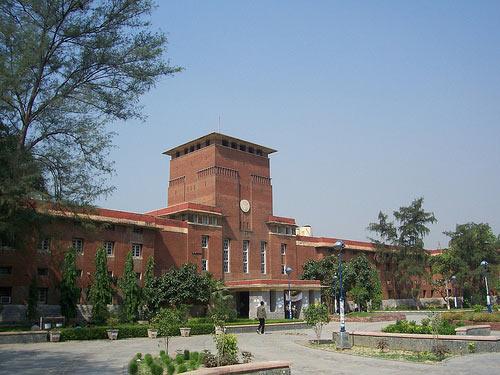Photographs: Chris Keane/Reuters Shubhashis Gangopadhyay
Building newer institutions may not be the answer to our higher education woes if we do not arrest the decline in the ones we already have.
Indians involved in the country's higher education system are somewhat shaken by the realisation that none of our leading educational institutes has made it to the list of the world's top 200 institutions.
Various people have given various reasons for this lacklustre performance.
For instance, the director of one of the Indian Institutes of Technology (IITs) has said that the ranking authorities use backdated data that are freely available on the Net for ranking Indian institutions.
The reason for this is that Indian institutions do not pay the money needed to be evaluated -- $150,000 (approximately Rs 94 lakh at the current exchange rate).
This obviously raises two issues.
First, do we care about the rankings; and, second, if we do care, do we care enough to pay this large sum of money?
After all, our educational institutes are starved of money and $150,000 goes away to support research and teaching activities in many departments.
Obviously, scoring a high rank is important if, otherwise, we are going to lose the good students.
If a good student has a chance to go to Harvard or to one of our local institutes and the Indian institute is ranked higher than Harvard, then she would, possibly, decide to join the Indian institution.
However, I do not think those are the relevant options that most Indian students face.
On the other hand, if a foreign student can stay in their own country or join one of the IITs, their ultimate decision could be determined by the rank of the particular IIT.
However, since attracting foreign students in large numbers is not a stated objective of our institutions, I do not think this, too, is the relevant question.
What is probably more important for us is that the ranking is an evaluation of how our education system is performing. And, in this sense, we should be worried about the low rank that we currently seem to get.
It is unfortunate that ever since the rankings came out, everyone has been discussing the IITs and their lack of performance.
What does not seem to be a cause for concern is that the University of Delhi, where Nobel Prize winner Amartya Sen was once a member of the faculty, has a rank between 441 and 450.
By comparison, the lowest rank among the IITs is 346. In India, universities have become the unwanted stepchildren of the higher education system.
For instance, specialised institutes set up all over the country get many, many times more funding than all universities put together.
These institutes are mostly science-only institutions (for example, the IITs, the Indian Institutes of Science Education and Research, and the Indian Institutes of Information Technology) with, if at all, a handful of non-science faculty members to service the science students.
The universities, on the other hand, have larger numbers and sizes of faculties and service a much larger group of students.
In fact, the question to ask is not simply how to improve the rankings of the IITs, but also whether we are judiciously spending our resources.
The writer Shubhashis Gangopadhyay is research director of IDF and director of the School of Humanities and Social Sciences at Shiv Nadar University.
Please click NEXT to continue reading...
Column: 'Indian universities are unwanted stepchildren'
Image: Delhi University was ranked among the top 100 list of global universities this yearPhotographs: Seek1/Wikimedia Commons
Let me explain what I mean.
Let us take the two Delhi institutions -- the IIT, Delhi, and Delhi University.
The rank of the IIT, Delhi, is 222, while that of Delhi University is between 441 and 450.
By the faculty-student ratio, the rank of the IIT, Delhi, is 467; for Delhi University, it is 858!
This is purely an issue of resources - per student, the resources for hiring faculty are a lot less in Delhi University than in the IIT, Delhi.
The academic reputation rank of the IIT, Delhi, is 215; it is 214 for Delhi University!
With a lot less resources and a lot more students, Delhi University marginally beats the IIT, Delhi, in terms of academic reputation.
I guess we have to stop pampering the Institutes with money and official attention and get back to concentrating resources on the Universities. In the mean time, we should be worried about a more significant indicator.
If we are to look at the rankings over time, the IIT, Delhi, has gone from 181 in 2009 to 222 in 2013; Delhi University started at 291 in 2009.
Observe that while the IIT director referring to lack of proper data may have been right in explaining our low ranks, that explanation may not be entirely applicable in explaining why our ranking has been coming down over time.
And, to me, that is of serious concern.
For that tells me that regardless of how we measure it, through randomly accessible internet data or through lagged data, our relative standards are falling.
Building newer institutions may not be the answer to our higher education woes if we do not arrest the decline in the ones we already have.
Another point worth making -- and this is not necessarily because I am biased -- is that resources also need to flow into the non-science and non-management areas.
Indeed, at the subject level rankings, Delhi University social sciences are ranked the highest at 200.
Higher education is not simply about skill training and, hence, universities with the possibility of interaction among students and faculty members from various disciplines are part of the learning process.
This is something we need to emphasise if we want our place in the knowledge economy.
Otherwise, we will be producing cheap labour for activities that economic superpowers will outsource to us.




Comment
article